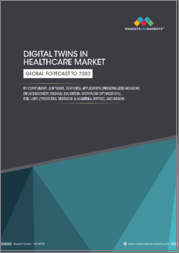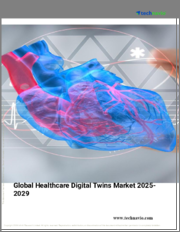
|
시장보고서
상품코드
1496127
세계의 헬스케어용 디지털 트윈 시장 : 현황 분석과 예측(2024-2032년)Digital Twin in Healthcare Market: Current Analysis and Forecast (2024-2032) |
||||||
헬스케어용 디지털 트윈 시장은 기업에 의한 투자 증가로 예측 기간 동안 CAGR 28.9%의 강력한 성장이 예상되고 있습니다. 헬스케어용 디지털 트윈 시장에 대한 투자가 증가하고 있는 배경은 환자 케어, 업무 효율, 비용 절감에 변화를 가져올 가능성이 있기 때문입니다. 헬스케어용 디지털 트윈 기술에 대한 최근 투자는 다음과 같습니다.
Siemens Healthineers: 2022년, Siemens Healthineers는 가상 모델링 및 시뮬레이션을 통해 의료 영상, 진단 및 환자 관리를 강화하기 위해 헬스케어용 디지털 트윈 기술에 대한 대규모 투자를 발표했습니다.
GE Healthcare: GE Healthcare는 의료기기의 예지보전과 병원 워크플로우 최적화에 중점을 두고 헬스케어용 디지털 트윈 솔루션에 투자하고 있습니다. 2023년에는 의료 부문을 위한 디지털 트윈 제공을 확대하기 위한 최근 투자가 보고되었습니다.
유형별로 볼 때 시장은 공정 시스템의 디지털 트윈과 제품의 디지털 트윈으로 이분됩니다. 프로세스 시스템의 디지털 트윈 부문은 2023년 시장에서 압도적인 점유율을 차지했습니다. 의료용 프로세스 시스템의 디지털 트윈은 업무 효율성 향상, 비용 절감, 환자 결과 개선을 목적으로 한 몇 가지 주요 요인이 주요 원동력이 되고 있습니다. 주요 촉진요인 중 하나는 의료 시설 내에서 효율적인 자산 및 프로세스 관리의 필요성입니다. 디지털 트윈을 통해 의료 제공업체는 작업의 정확한 시뮬레이션을 생성할 수 있어 더 나은 자원 배분, 유지보수 스케줄링, 의료 자산의 전반적인 관리가 가능합니다.
애플리케이션별로 시장은 자산, 프로세스 관리, 맞춤형 의료, 의약품 등으로 구분됩니다. 신약 부문은 앞으로 일정 기간 동안 높은 CAGR로 성장할 것으로 예상됩니다. 헬스케어용 디지털 트윈 시장의 창약 부문은 의약품 개발 및 시장 출시 방법을 변화시키는 것을 목표로 하는 몇 가지 설득력 있는 요인에 의해 추진되고 있습니다. 주요 촉진요인은 신약의 연구 개발과 관련된 시간과 비용을 크게 줄일 수 있습니다. 디지털 트윈은 시뮬레이션된 인간 생리학에서 약물 상호작용의 가상 시험을 가능하게 하여 대규모 물리적 시험의 필요성을 감소시킵니다.
최종 사용자별로 보면 시장은 병원 및 클리닉, 임상연구기관 등으로 구분됩니다. 2023년 시장에서는 병원 및 클리닉이 압도적인 점유율을 차지하고 있습니다. 이 부문은 시설 관리, 환자 흐름 최적화, 의료기기 관리 등 다양한 목적으로 디지털 트윈을 사용합니다. 병원 운영 및 환자와의 상호 작용을 시뮬레이션함으로써 병원은 자원 배분을 최적화하고 환자 결과를 개선할 수 있습니다.
의료 산업에서 디지털 트윈 시장 도입에 대한 이해를 높이기 위해 시장은 북미(미국, 캐나다 및 기타 북미), 유럽(독일, 영국, 프랑스, 스페인, 이탈리아 및 기타 유럽), 아시아태평양( 중국, 일본, 인도 및 기타 아시아태평양) 및 기타 지역에서 세계의 존재를 바탕으로 분석됩니다. 아시아태평양은 향후 일정 기간 높은 CAGR로 성장할 것으로 예상됩니다. 아시아태평양의 헬스케어용 디지털 트윈 시장의 성장을 뒷받침하는 몇 가지 원동력이 있습니다. 첫째, AI, IoT, 클라우드 컴퓨팅 등의 급속한 기술 진보가 의료 분야에 맞는 정교한 디지털 트윈 솔루션의 개발을 촉진하고 있습니다. 이러한 혁신은 실시간 모니터링, 예측 분석, 개인화된 의료 서비스 제공을 가능하게 하며, 이 지역의 의료 서비스 제공업체에서 디지털 트윈 채택을 촉진하고 있습니다. 게다가, 의료비 증가, 가치 기반 케어 및 환자 중심 접근법의 중요성 증가는 임상 결과와 업무 효율성을 개선하기 위해 디지털 트윈을 포함한 디지털 건강 솔루션에 대한 투자를 촉구합니다.
이 시장에서 사업을 전개하는 주요 기업으로는 Atos SE, Koninklijke Philips NV, Altair Engineering Inc., Verto Health, Twin Health, Dassault Systemes, Predisurge, Virtonomy GmbH, Siemens Healthineers AG, Microsoft 등이 있습니다.
목차
제1장 시장 소개
- 시장의 정의
- 주요 목표
- 이해관계자
- 제한 사항
제2장 조사 방법 또는 전제조건
- 조사 과정
- 조사 방법
- 응답자 프로파일
제3장 주요 요약
제4장 시장 역학
- 성장 촉진요인
- 기회
- 억제요인
- 동향
- PESTEL 분석
- 수요측 분석
- 공급측 분석
- 합병과 인수
- 투자 시나리오
- 업계 인사이트: 대기업 스타트업 기업과 그 독자적인 전략
제5장 가격 분석
- 지역별 가격 분석
- 가격에 영향을 미치는 요인
제6장 세계의 헬스케어용 디지털 트윈 시장 수익(2022-2032년)
제7장 시장 분석 : 유형별
- 프로세스 시스템의 디지털 트윈
- 제품의 디지털 트윈
제8장 시장 분석 : 용도별
- 자산 및 프로세스 관리
- 맞춤형 의료
- 창약
- 기타
제9장 시장 분석 : 최종 사용자별
- 병원 및 클리닉
- 임상연구기관
- 기타
제10장 시장 분석 : 지역별
- 북미
- 미국
- 캐나다
- 기타 북미
- 유럽
- 독일
- 영국
- 프랑스
- 이탈리아
- 스페인
- 기타 유럽
- 아시아태평양
- 중국
- 일본
- 인도
- 기타 아시아태평양
- 세계 기타 지역
제11장 밸류체인 분석
- 한계 분석
- 시장 진출기업 일람
제12장 경쟁 구도
- 경쟁 대시보드
- 경쟁 시장 포지셔닝 분석
- Porter's Five Forces 분석
제13장 기업 프로파일
- Atos SE
- Company Overview
- Key Financials
- SWOT Analysis
- Product Portfolio
- Recent Developments
- Koninklijke Philips NV
- Altair Engineering Inc.
- Verto Health
- Twin Health
- Dassault Systemes
- PrediSurge
- Virtonomy GmbH
- Siemens Healthineers AG'
- Microsoft
제14장 약어와 전제조건
제15장 부록
JHS 24.06.25In recent years, the concept of digital twins has emerged as a transformative force across various industries, including healthcare. Rooted in simulation, data analytics, and IoT (Internet of Things), digital twins offer a virtual replica or representation of physical entities, be it a machine, a process, or, in the case of healthcare, a patient. This paradigm shift in healthcare leverages advanced technologies to create a comprehensive digital counterpart of an individual's health profile, encompassing physiological parameters, medical history, genetic makeup, and lifestyle factors. By integrating real-time data streams from wearable devices, medical sensors, electronic health records (EHRs), and other sources, digital twins enable healthcare providers to monitor, analyze, and predict health outcomes with unprecedented accuracy and granularity. As healthcare systems strive to embrace innovation and harness the power of digital transformation, digital twins stand poised to redefine the landscape of healthcare delivery, ushering in an era of precision medicine and proactive wellness management.
The Digital Twin in Healthcare Market is expected to grow at a strong CAGR of 28.9% during the forecast period owing to increasing investment by companies. The growing investment in digital twins within the healthcare market is driven by the potential for transformative impact on patient care, operational efficiency, and cost reduction. Recent investments in digital twin technology in healthcare include:
Siemens Healthineers: In 2022, Siemens Healthineers announced significant investments in digital twin technology for healthcare applications, aiming to enhance medical imaging, diagnostics, and patient care through virtual modeling and simulation.
GE Healthcare: GE Healthcare has been investing in digital twin solutions for healthcare, focusing on predictive maintenance for medical equipment and optimizing hospital workflows. Recent investments were reported in 2023 to expand their digital twin offerings in the healthcare sector.
Based on types, the market is bifurcated into process & system digital twin, and product digital twin. The process & system digital twin segment held the dominant share of the market in 2023. The process and system digital twins in healthcare are primarily driven by several key factors that aim to enhance operational efficiency, reduce costs, and improve patient outcomes. One major driving factor is the need for efficient asset and process management within healthcare facilities. Digital twins enable healthcare providers to create accurate simulations of their operations, allowing for better resource allocation, maintenance scheduling, and overall management of medical assets.
By application, the market is segmented into asset and process management, personalized medicine, drug discovery, and others. The drug discovery segment is anticipated to grow with a high CAGR during the forthcoming period. The drug discovery segment in the digital twin market in healthcare is propelled by several compelling factors that aim to revolutionize how pharmaceuticals are developed and brought to market. A primary driver is the potential for significant reductions in time and cost associated with the R&D of new drugs. Digital twins allow for the virtual testing of drug interactions within simulated human physiology, reducing the need for extensive physical trials.
Based on end users, the market is segmented into hospitals and clinics, clinical research organizations, and others. The hospitals and clinics held the dominant share of the market in 2023. This segment uses digital twins for various purposes including facility management, patient flow optimization, and medical equipment management. By simulating hospital operations and patient interactions, hospitals can optimize resource allocation and improve patient outcomes.
For a better understanding of the market adoption of the digital twin in the healthcare industry, the market is analyzed based on its worldwide presence in countries such as North America (U.S., Canada, Rest of North America), Europe (Germany, U.K., France, Spain, Italy, Rest of Europe), Asia-Pacific (China, Japan, India, Rest of Asia-Pacific), Rest of World. Asia Pacific is anticipated to grow with a high CAGR during the forthcoming period. Several driving factors are propelling the growth of the Asia Pacific digital twin in the healthcare market. Firstly, rapid technological advancements, such as AI, IoT, and cloud computing, are fostering the development of sophisticated digital twin solutions tailored to the healthcare sector. These innovations enable real-time monitoring, predictive analytics, and personalized healthcare delivery, driving the adoption of digital twins among healthcare providers in the region. Moreover, increasing healthcare expenditure and a growing emphasis on value-based care and patient-centric approaches incentivize investments in digital health solutions, including digital twins, to improve clinical outcomes and operational efficiency. Additionally, government initiatives promoting healthcare digitization, such as the National Digital Health Mission in India launched in 2020, are driving awareness and adoption of digital health technologies, including digital twins, among healthcare stakeholders in the Asia Pacific region.
Some of the major players operating in the market include Atos SE; Koninklijke Philips N.V.; Altair Engineering Inc.; Verto Health; Twin Health; Dassault Systemes; PrediSurge; Virtonomy GmbH; Siemens Healthineers AG'; and Microsoft.
TABLE OF CONTENTS
1.MARKET INTRODUCTION
- 1.1. Market Definitions
- 1.2. Main Objective
- 1.3. Stakeholders
- 1.4. Limitation
2.RESEARCH METHODOLOGY OR ASSUMPTION
- 2.1. Research Process of the Digital Twin In Healthcare Market
- 2.2. Research Methodology of the Digital Twin In Healthcare Market
- 2.3. Respondent Profile
3.EXECUTIVE SUMMARY
- 3.1. Industry Synopsis
- 3.2. Segmental Outlook
- 3.2.1. Market Growth Intensity
- 3.3. Regional Outlook
4.MARKET DYNAMICS
- 4.1. Drivers
- 4.2. Opportunity
- 4.3. Restraints
- 4.4. Trends
- 4.5. PESTEL Analysis
- 4.6. Demand Side Analysis
- 4.7. Supply Side Analysis
- 4.7.1. Merger & Acquisition
- 4.7.2. Investment Scenario
- 4.7.3. Industry Insights: Leading Startups and Their Unique Strategies
5.PRICING ANALYSIS
- 5.1. Regional Pricing Analysis
- 5.2. Price Influencing Factors
6.GLOBAL DIGITAL TWIN IN HEALTHCARE MARKET REVENUE (USD BN), 2022-2032F
7.MARKET INSIGHTS BY TYPE
- 7.1. Process & System Digital Twin
- 7.2. Product Digital Twin
8.MARKET INSIGHTS BY APPLICATION
- 8.1. Asset and Process Management
- 8.2. Personalized Medicine
- 8.3. Drug Discovery
- 8.4. Others
9.MARKET INSIGHTS BY END USER
- 9.1. Hospital and Clinics
- 9.2. Clinical Research Organizations
- 9.3. Others
10.MARKET INSIGHTS BY REGION
- 10.1. North America
- 10.1.1. U.S.
- 10.1.2. Canada
- 10.1.3. Rest of North America
- 10.2. Europe
- 10.2.1. Germany
- 10.2.2. U.K.
- 10.2.3. France
- 10.2.4. Italy
- 10.2.5. Spain
- 10.2.6. Rest of Europe
- 10.3. Asia-Pacific
- 10.3.1. China
- 10.3.2. Japan
- 10.3.3. India
- 10.3.4. Rest of Asia-Pacific
- 10.4. Rest of World
11.VALUE CHAIN ANALYSIS
- 11.1. Marginal Analysis
- 11.2. List of Market Participants
12.COMPETITIVE LANDSCAPE
- 12.1. Competition Dashboard
- 12.2. Competitor Market Positioning Analysis
- 12.3. Porter Five Force Analysis
13.COMPANY PROFILED
- 13.1. Atos SE
- 13.1.1. Company Overview
- 13.1.2. Key Financials
- 13.1.3. SWOT Analysis
- 13.1.4. Product Portfolio
- 13.1.5. Recent Developments
- 13.2. Koninklijke Philips N.V.
- 13.3. Altair Engineering Inc.
- 13.4. Verto Health
- 13.5. Twin Health
- 13.6. Dassault Systemes
- 13.7. PrediSurge
- 13.8. Virtonomy GmbH
- 13.9. Siemens Healthineers AG'
- 13.10. Microsoft



















